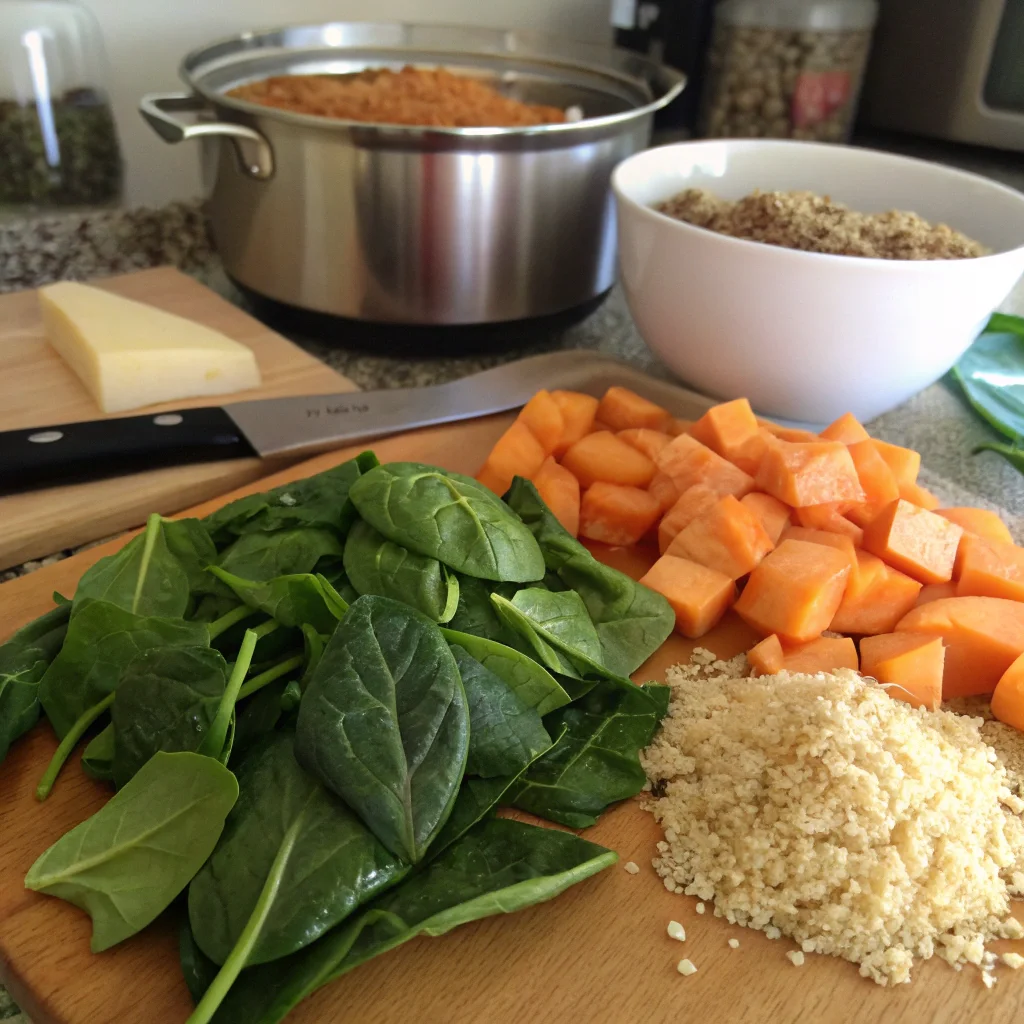Introduction to Healthy Protein Soup Recipes
Healthy protein soup recipes have gained immense popularity among fitness enthusiasts and health-conscious individuals. They provide a delicious and convenient way to meet your daily protein needs. Whether you aim to build muscle, lose weight, or simply maintain a balanced diet, these soups are an excellent addition to your meal plan.
The versatility of soups allows you to blend various nutrient-dense ingredients, creating flavorful meals that suit diverse dietary preferences. From hearty animal-based broths to plant-powered vegan options, there’s something for everyone. In this guide, we will explore the benefits of healthy protein soup recipes, the best ingredients to use, and some must-try recipes to inspire your kitchen adventures.
The Benefits of Healthy Protein Soup Recipes
Why Protein is Essential for a Balanced Diet
Protein plays a crucial role in maintaining overall health. It supports muscle growth, repair, and maintenance while also playing a part in hormone production and immune function. Without enough protein, you may feel fatigued, experience slower recovery from workouts, and struggle to maintain a healthy weight.
- Satiety and Weight Management: Protein-rich foods keep you full longer, reducing unnecessary snacking.
- Muscle Health: Regular intake of protein helps prevent muscle loss, especially with age.
- Metabolism Boost: Protein requires more energy to digest, helping your body burn calories even at rest.
Including healthy protein soup recipes in your diet ensures that you meet your daily protein goals without sacrificing flavor.
The Advantages of Soups as a Protein Source
Soups are not only comforting but also nutrient-dense, making them a perfect medium for incorporating protein. They provide a balance of hydration and nutrition, which is essential for overall wellness.
- Digestive Benefits: Soups are easy to digest, making them ideal for those recovering from illness or dealing with digestive issues.
- Customizable Nutrition: You can adjust the ingredients to match your dietary needs, whether it’s low-carb, high-protein, or gluten-free.
- Convenience: Healthy protein soup recipes can be made in large batches and stored for quick, nutritious meals throughout the week.
Moreover, soups combine protein with essential vitamins and minerals, making them a well-rounded meal option.
Top Ingredients for Healthy Protein Soup Recipes
Animal-Based Protein Ingredients
For those who consume animal products, there are numerous options to boost the protein content of your soups.
- Chicken and Turkey: These lean meats are rich in protein and low in fat.
- Beef: Opt for lean cuts or ground beef to reduce saturated fat.
- Fish and Seafood: Salmon, shrimp, and cod not only add protein but also provide omega-3 fatty acids.
- Eggs: Add a poached egg to soups for a creamy texture and an extra protein punch.
These ingredients enhance the taste and texture of your soups while delivering a hefty dose of protein.
Plant-Based Protein Ingredients
Plant-based options are just as effective in creating protein-rich soups. They are particularly suitable for vegetarians, vegans, and those looking to reduce their meat consumption.
- Legumes: Lentils, chickpeas, and black beans are affordable and protein-packed.
- Tofu and Tempeh: These soy-based products blend seamlessly into soups and absorb flavors beautifully.
- Quinoa: This superfood adds both protein and texture to your soups.
- Nuts and Seeds: Almonds, cashews, and chia seeds can be used to thicken soups while boosting protein.
These nutrient-dense options ensure that even plant-based soups deliver the protein your body needs.
10 Must-Try Healthy Protein Soup Recipes
1. Classic Chicken and Vegetable Protein Soup
A timeless favorite that combines lean chicken breast with fresh vegetables. This soup is not only high in protein but also rich in vitamins.
2. Spicy Lentil Protein Soup
Packed with fiber and plant-based protein, this vegan-friendly soup is seasoned with warming spices like cumin and turmeric.
For a hearty and plant-based option, consider trying this flavorful Vegetarian Lasagna Soup packed with protein-rich lentils and vegetables.
3. Creamy Coconut and Tofu Soup
This dairy-free option uses silken tofu and coconut milk to create a creamy, satisfying dish.
4. Beef and Barley Protein Soup
A hearty choice that combines tender beef chunks with chewy barley, making it both filling and nutritious.
5. Mediterranean Chickpea Soup
This recipe is high in protein and fiber, featuring chickpeas, tomatoes, and Mediterranean herbs.
6. Salmon and Spinach Protein Soup
Rich in omega-3 fatty acids, this soup is a nutritional powerhouse with a light, refreshing taste.
7. Turkey and Sweet Potato Protein Soup
This lean protein soup pairs turkey with sweet potatoes, offering a perfect balance of savory and sweet flavors.
8. Black Bean and Corn Protein Soup
A Tex-Mex-inspired dish that’s loaded with protein, fiber, and bold flavors.
9. Creamy Broccoli and Cheddar Protein Soup
This indulgent yet healthy option combines broccoli with protein-rich cheddar cheese.
10. Thai-Style Shrimp and Coconut Soup
This high-protein soup blends shrimp with coconut milk, lime, and lemongrass for a deliciously exotic taste.
Tips for Making Your Own Healthy Protein Soup Recipes
Choosing the Right Protein Base
Selecting the right base is essential for crafting healthy protein soup recipes.
- Broths and Stocks: Start with chicken, beef, or vegetable stock for added flavor.
- Plant-Based Alternatives: Use miso or vegetable bouillon for vegetarian soups.
- Pre-Cooked Options: Rotisserie chicken or canned beans save time without sacrificing nutrition.
These bases ensure your soup is both flavorful and protein-rich.
Adding Nutrient-Packed Vegetables
Vegetables not only enhance the flavor of your soups but also boost their nutrient content.

- Leafy Greens: Spinach, kale, and Swiss chard are rich in vitamins and antioxidants.
- Root Vegetables: Carrots, parsnips, and sweet potatoes add natural sweetness and fiber.
- Cruciferous Veggies: Broccoli and cauliflower offer a subtle crunch and extra nutrition.
Incorporate a variety of vegetables to make your soups as nutrient-dense as possible.
Incorporating versatile ingredients like butternut squash can enhance both the flavor and nutritional value of your soup. For inspiration, explore this delightful Butternut Squash Soup Recipe.
Seasoning for Maximum Flavor
A well-seasoned soup is the key to a satisfying meal.
- Herbs and Spices: Use rosemary, thyme, paprika, or curry powder for depth.
- Acidic Elements: Lemon juice, vinegar, or tomatoes brighten flavors.
- Healthy Fats: Olive oil or avocado enhances texture and taste.
These seasoning tips ensure your healthy protein soup recipes are both delicious and nutritious.
Common Mistakes to Avoid in Healthy Protein Soup Recipes
Making healthy protein soup recipes may seem straightforward, but certain missteps can compromise flavor, texture, and nutritional value. By identifying and avoiding these common mistakes, you can ensure your soups turn out perfect every time.
1. Overcooking Ingredients
Overcooking is one of the most common errors, leading to mushy vegetables and tough proteins. Prolonged cooking not only affects texture but also diminishes the nutritional content of the ingredients.
- Vegetables: Cook vegetables until just tender to retain their vitamins and minerals. Adding them in stages can ensure they don’t overcook.
- Proteins: Overcooking chicken, fish, or tofu can result in dryness or a rubbery texture. Monitor cooking times and use a thermometer for accuracy when needed.
2. Using Too Much Salt
Salt enhances flavor but using too much can make your soup overly salty and unhealthy.
- Alternative Seasonings: Rely on herbs, spices, and acidic ingredients like lemon juice or vinegar to elevate flavor without excess sodium.
- Homemade Broth: Store-bought broths can be high in sodium. Opt for homemade or low-sodium versions to control salt levels.
3. Ignoring Protein Add-Ins
Failing to include adequate protein-rich ingredients can leave your soup less satisfying and unbalanced.
- Simple Solutions: Beans, lentils, quinoa, or shredded chicken are easy additions to boost protein.
- Planning Ahead: Decide on your primary protein source before starting to ensure it complements the other ingredients.
4. Not Balancing Flavors
A well-balanced soup requires more than just protein; you need to consider the interplay of savory, sweet, sour, and spicy elements.
- Acidic Ingredients: A splash of lemon juice or a dash of vinegar at the end of cooking can brighten flavors.
- Sweetness: Adding a touch of sweetness with carrots, sweet potatoes, or a pinch of sugar can balance overly acidic or spicy soups.
5. Failing to Blend Textures
Soups that lack a balance of textures can feel monotonous. Including a mix of chunky ingredients and creamy elements creates a more enjoyable eating experience.
- Blending Options: Purée part of the soup with a blender for creaminess while leaving chunks for variety.
- Toppings: Add crunchy toppings like toasted nuts, seeds, or croutons for contrast.
6. Skipping Meal Prep
Soup is an ideal meal prep option, but failing to plan ahead can make the process more time-consuming and stressful.
- Batch Cooking: Make large quantities and freeze portions for easy meals later.
- Storing Tips: Use airtight containers to maintain freshness and prevent freezer burn.
7. Using Low-Quality Ingredients
The quality of your ingredients significantly impacts the taste and nutritional value of your soup.
- Fresh Ingredients: Choose fresh, seasonal vegetables and high-quality proteins for the best results.
- Avoiding Pre-Packaged Options: Pre-packaged or processed ingredients may contain additives and excess sodium.
8. Forgetting Nutritional Balance
While protein is important, a truly healthy soup should include a balance of macronutrients.
- Carbohydrates: Add whole grains like quinoa or farro for sustained energy.
- Healthy Fats: Use olive oil, avocado, or nuts to enhance flavor and provide essential fats.
FAQs About Healthy Protein Soup Recipes
What Can I Add to Soup for More Protein?
Adding protein-rich ingredients to your soup is an easy way to boost its nutritional value. Here are some effective options:
- Animal-Based Proteins: Include shredded chicken, diced turkey, lean beef, or seafood such as shrimp or salmon.
- Plant-Based Proteins: Add lentils, chickpeas, black beans, or tofu for vegetarian options.
- Dairy and Eggs: Stir in Greek yogurt, cottage cheese, or a poached egg for extra protein and creaminess.
- Grains and Seeds: Incorporate quinoa, farro, or chia seeds for a protein and texture boost.
These additions enhance not only the protein content but also the flavor and texture of your soup.
What Is the Healthiest Soup You Can Eat?
The healthiest soup depends on your dietary preferences, but some general guidelines apply:
- High-Protein Soups: Opt for chicken and vegetable soup, lentil soup, or miso soup with tofu.
- Low-Calorie Options: Clear broths with lean protein and non-starchy vegetables are great choices.
- Nutrient-Dense Soups: Soups packed with leafy greens, legumes, and healthy fats like olive oil or avocado offer balanced nutrition.
A healthy soup combines high-quality protein, ample vegetables, and minimal added salt or processed ingredients.
If you’re following a low-carb diet, this protein-packed Keto Lasagna Soup is an excellent choice for a nutritious and satisfying meal.
How Much Protein Is in Taco Soup?
Taco soup’s protein content depends on the ingredients used. On average:
- Ground Beef or Turkey Base: Provides approximately 20-25 grams of protein per serving.
- Beans: Adding black beans or kidney beans contributes another 7-10 grams per serving.
- Cheese and Greek Yogurt Toppings: These can add an additional 5-10 grams of protein.
Altogether, a serving of taco soup can deliver between 25-40 grams of protein, making it a hearty, high-protein meal.
Which Lentils Are High in Protein?
All lentils are high in protein, but some varieties stand out:
- Red Lentils: Contain about 18 grams of protein per cup (cooked). They cook quickly and are ideal for soups.
- Green Lentils: Provide 17 grams of protein per cup and hold their shape well in stews.
- Black Lentils (Beluga): Offer around 13 grams of protein per cup and have a unique, earthy flavor.
Incorporating any of these lentils into your soups boosts their protein content while adding fiber and nutrients.
What Has More Protein, Eggs or Lentils?
When comparing eggs and lentils, their protein content varies slightly:
- Eggs: One large egg contains about 6 grams of protein.
- Lentils: One cup of cooked lentils offers approximately 18 grams of protein.
While lentils have more protein per serving, eggs provide a complete protein profile with all essential amino acids. Combining both in a recipe can create a balanced meal.
Which Bean Has the Highest Protein?
Beans are excellent sources of plant-based protein, but the following stand out:
- Soybeans (Edamame): Lead the pack with 31 grams of protein per cup (cooked).
- Lentils: While technically a legume, they offer 18 grams per cup.
- Black Beans and Kidney Beans: Each provides about 15 grams of protein per cup.
Using these beans in healthy protein soup recipes ensures a nutritional powerhouse in every bowl.
Conclusion
Healthy protein soup recipes are a versatile and delicious way to meet your nutritional goals. Whether you prefer animal-based proteins or plant-based alternatives, these soups offer endless possibilities for creativity in the kitchen. By incorporating nutrient-packed ingredients and avoiding common pitfalls, you can enjoy meals that are not only satisfying but also aligned with your health objectives.
Make healthy protein soup recipes a staple in your diet, and you’ll reap the benefits of improved energy, better digestion, and a stronger immune system. Start experimenting today to discover your favorite combinations!






